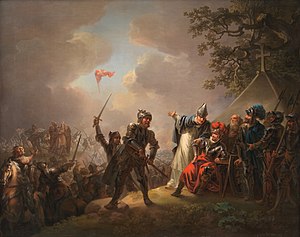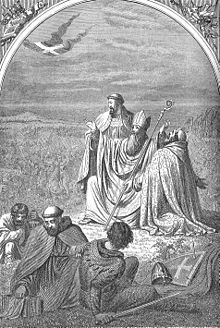Battle of Lyndanisse
| Battle of Lyndanisse | |||||||
|---|---|---|---|---|---|---|---|
| Part of Northern Crusades | |||||||
 Dannebrog falling from the sky during the Battle of Lyndanisse. | |||||||
| |||||||
| Belligerents | |||||||
| Revalia, Harria | Denmark | ||||||
| Commanders and leaders | |||||||
| Valdemar II | |||||||
| Strength | |||||||
| 1000-2000 | "several thousand" | ||||||
| Casualties and losses | |||||||
| 1000+ | ? | ||||||
The Battle of Lyndanisse was a battle which helped King Valdemar II of Denmark establish the territory of Danish Estonia during the Northern Crusades. Valdemar II defeated the Estonians at Lyndanisse (Estonian: Lindanise), during the Northern Crusades, by orders from the Pope. [1]
The Battle
Valdemar II, along with Archbishop Anders Sunesen of Lund, Bishop Theoderik of Estonia, and his vassals Count Albert of Nordalbingia and Vitslav I of Rügen, sailed to the northern Estonian province of Revalia at the beginning of July. The crusading army camped at Lyndanisse and built a castle there, named Castrum Danorum, which the Estonians called Taani-linn (later Tallinn), meaning Danish castle. The Estonians sent several negotiators, but they were only playing for time as they assembled an army large enough to fight the Danes. [2]
On 15 June, 1219, the Estonians attacked the Danes near the castle, right after suppertime. They advanced from five different directions and completely surprised the crusaders, who fled in all directions. Bishop Theoderik was killed by the Estonians, who thought he was the king. The Danes were saved by their Wendish vassals, as Vitslav lead a quick counterattack which stopped the Estonian advance. This gave the crusaders time to regroup, and the Estonians were routed.
Dannebrog

[3]Legend holds that during the battle of Lyndanisse, in the Danes' hour of need, the Danish flag, the Dannebrog, fell from the sky and gave them renewed hope. As the Estonians attacked the Danish stronghold, the Danes were hard pressed. Anders Sunesen, the Archbishop of Lund, raised his hands to the sky in prayer, and the defenders held tight as long as his hands were raised. As Archbishop Sunesen became exhausted, he eventually had to lower his arms, and the Estonians were on the verge of victory. Then, a red flag with a white cross fell from the sky, and gave the Danes the victory.
[4]
This account builds on two different versions from the early 16th century, of an even older source. According to legend, Denmark received its national flag, the Dannebrog, during the battle. This legend is mentioned in History of the Kings and heroes of the Danes in the last three volumes (14-16) which describe Danish conquests on the south shore of the Baltic Sea and the Northern Crusades. The Latin volumes of Danorum Regum heroumque Historiae, were edited by Danish Canon, Christiern Pedersen, and published by Jodocus Badiuson March 15, 1514.
This older source set the emergence of Dannebrog as a battle in Livonia in 1208. But the Franciscan monk Peder Olsen (c. 1527) rectified the year as 1219. The legend became affixed to the Battle of Lyndanisse. The legend of Dannebrog as originating in the Northern Crusades holds true, as the red flag with a white cross originated as a crusader symbol.[4]
See also
- Castrum Danorum
- Danish Estonia
- Flag of Denmark
- History of Estonia
- Livonian Crusade
- Northern Crusades
References
Other sources
- Urban William L. The Baltic Crusade (Northern Illinois University Press. 1994) ISBN 0875800521
- Lindholm, David; Nicolle, David The Scandinavian Baltic Crusades 1100-1500 (Osprey Publishing; 2007) ISBN 978-1841769882
- Christiansen, Eric Northern Crusades: The Baltic and the Catholic Frontier (University of Minnesota Press, 1981) ISBN 978-0140266535
